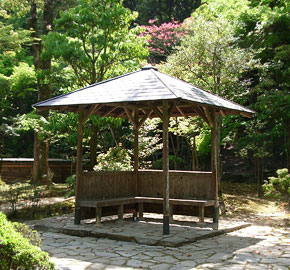|
||
 |
||
1 A simple, rustic hut of thatch found in rural areas during the Asuka, Nara, and Heian periods, particularly in the eastern part of Japan. Also written 四阿, and pronounced azuma or shia. Shia was originally a Chinese term for a square-plan structure with a pyramidal roof, and *shia 四阿 literally means 4 eaves. Azumaya signified a thatched hut with four posts and a pyramidal roof.
2 The mid-16c dictionary, UNPOIROHASHUU 運歩色葉集, describes azumaya as a simple structure without walls, open on all four sides.
3 In the Edo period, the terms azumaya and azumaya-zukuri 東屋造 were used widely to designate vernacular structures with hipped *yosemune-zukuri 寄棟造 roofs. However, the closely related term azuma 東 often is used to refer to a gable, particularly in the case of a truncated hipped roof or the roof-type known as kabutomune 兜棟, for example in Fukushima prefecture. Likewise the term azuma-zukuri refers to gabled roofs in Ishikawa prefecture and kabutomune roofs in Kumamoto prefecture.
4 A thatched building without walls built in the rustic style in a landscape garden as a place for participants of a tea ceremony to sit and rest. The typical example has four posts, a square plan, and a pyramidal roof, although some are circular or octagonal. Alternatively referred to as chin 亭, tei 亭, shia 四阿.

Shuuentei 聚遠亭 (Hyougo)
(C)2001 Japanese Architecture and Art Net Users System. No reproduction or republication without written permission.
掲載のテキスト・写真・イラストなど、全てのコンテンツの無断複製・転載を禁じます。

